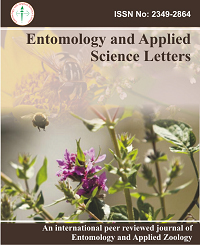
Applied Science Letters


The purpose of this study was to investigate the presence of Aeromonas hydrophila in freshwater crayfish on the river Aras Dam and to determine the in-vitro antimicrobial susceptibility and Heavy metal resistance of isolates. In total, 150 Crayfish samples were collected and 22.66% of them were positive for A. hydrophila. The A. hydrophila were recovered from Crayfish, cultured on TSA and cytophaga agar and identified by biochemical tests. Detection of drug susceptibility was determined using disc diffusion method to Ciprofloxacin (5 μg), Trimethoprim (5 μg), Chloramphenicol (30 μg), Amikacin (30 μg), Clindamycin (2 μg), Oxacilin (1 μg), Ampicillin (10 μg), Gentamicin (10 μg), Tetracycline (30 μg), Vancomycin (30 μg), Ofloxacin (5 μg), Streptomycin ( μg), Kanamycin (30 μg), Imipenem (10 μg) and Cefazolin (30 μg). Most of the isolates showed multi-drug resistance to two or more antibiotics. Trimethoprim, Imipenem and Tetracycline, were the most sensitive drugs with 100% efficacy whereas Oxacilin, Ampicillin and Vancomycin were the most resistant drugs having 94.12%, 47.05% and 32.35% resistance, respectively. There was low resistance against Ofloxacin (14.71%) and gentamicin (5.88%). Most isolates were tolerant to different concentrations of various heavy metals, as evidenced by their MICs ranging from 6.25 μg/mL to >3200 μg/mL.
Keywords: Antibiotic and heavy metal Susceptibility, bacteria, crayfish
Unestam T. Freshwater Crayfish, 1973, 1, 136–150.
Vogt G. (Ed. by F. Gherardi, D.M. Holdich), pp. 87– 103. A.A. Balkema Publishers, Netherlands, 1999.
Edgerton, B. F., Evans, L. H., Stephens, F. J., Overstreet, R. M., Aquaculture, 2002, 206, 57-135.
Post, G. W. Textbook of fish health J.F.H population, Inc Ltd. 211west syyania Avenue Neptune City NJ00753, 1989.
Zorrilla, M., Chabrillon, A. S., Rosales, P. D, Manzanares, E. M, Balebona, M. C. and Morinigo, M. A. Aquaculture, 2003, 218, 11-20.
Groff, J. M. and S. R. Lapatra. Journal of Applied Aquaculture, 2000, 10(4), 17-90.
Karunasagar, I., I. karunasagar and. Otta, S. k. Journal of Applied Aquaculture, 2003, 13(3/4), 231-249
Quaglio, R., Manfrin, A., Nobile, L., Delgado, M. L., Maxia, M., Morolli, C. G. and Fioravanti, M. L. Freshwater Crayfish, 2002, 13, 280-286
Janda, J. M., Abboh, S. L., Khashe, S., Kellogg, G. H. and Shimada, T. Journal of clinical Microbiology, 1996, 34,1930-1983
Kellogg, A. Fresh water Crayfish, 1977, 6, 212-222.
Fiorentini C, Barbieri E, Falzano L, Matarrese P, Baffone W, Pianetti A, Katouli M, Kuhn I, Mollby R, Bruscolini F, Casiere A, Donelli G: J Appl Bacteriol, 1998, 85, 501-511.
MY Yahyazadeh, M Seidgar, S Shiri. Iranian Journal of Aquatic Animal Health, 2015, 2 (1) 80-86.
Sam Cookiyaei A.; Afsharnasab M.; Razavilar V.; Motalebi A. A.;Kakoolaki S.; Asadpor Y.; Yahyazade M. Y.;Nekuie Fard A. Iranian Journal of Fisheries Sciences, 2012, 11(3) 644-656.
Bauer, A. W., W. M. M. Kirby, J. C. Sherris, and M. Turck. Am. J. Clin. Pathol, 1966, 36:493-496.
Olasumbo L. Akinbowale, Haihong Peng, Peter Grant, Mary D. Barton. International Journal of Antimicrobial Agents, 2007, 177–182
Yillia PT, Kreuzinger N, Mathooko JM. Phys. Chem. Earth, 2008, 33(8-13):729-737.
M. Go˜ni-Urriza,M. Capdepuy, C. Arpin, N. Raymond, and C. Q. Applied and Environmental Microbiology, 2000, 66 (1) 125–132.
Isoken H. Igbinosa and Anthony I. Okoh. The Scientific World Journal, 2012.
G. Vivekanandhan, K. Savithamani, A.A.M. Hatha, P. Lakshmanaperumalsamy. International Journal of Food Microbiology, 2002, 76; 165– 168.
Ugur A, Ceylan O. Arch Med Res, 2003, 34:130–6.
Karbasizaed V, Badami N, Emtiazi G. Afr J Biotechnol, 2003, 2:379–83.
Miranda CD, Castillo G. Sci Total Environ, 1998, 224:167–76.
Pathak SP, Gopal K. Environ Res, 2005, 98:100–3.
C.D. Miranda1, G. Castillo. 1998. The Science of the Total Environment, 224. 167- 176
Boujamaa I. The Scientific World Journal, 2001, 1l 796-807.
SummersAO. Clin Infect Dis, 2002, 34(Suppl. 3):S85–92.
Alonso A, Sanchez P, Martinez JL. Environ Microbiol, 2001; 3:1–9.
